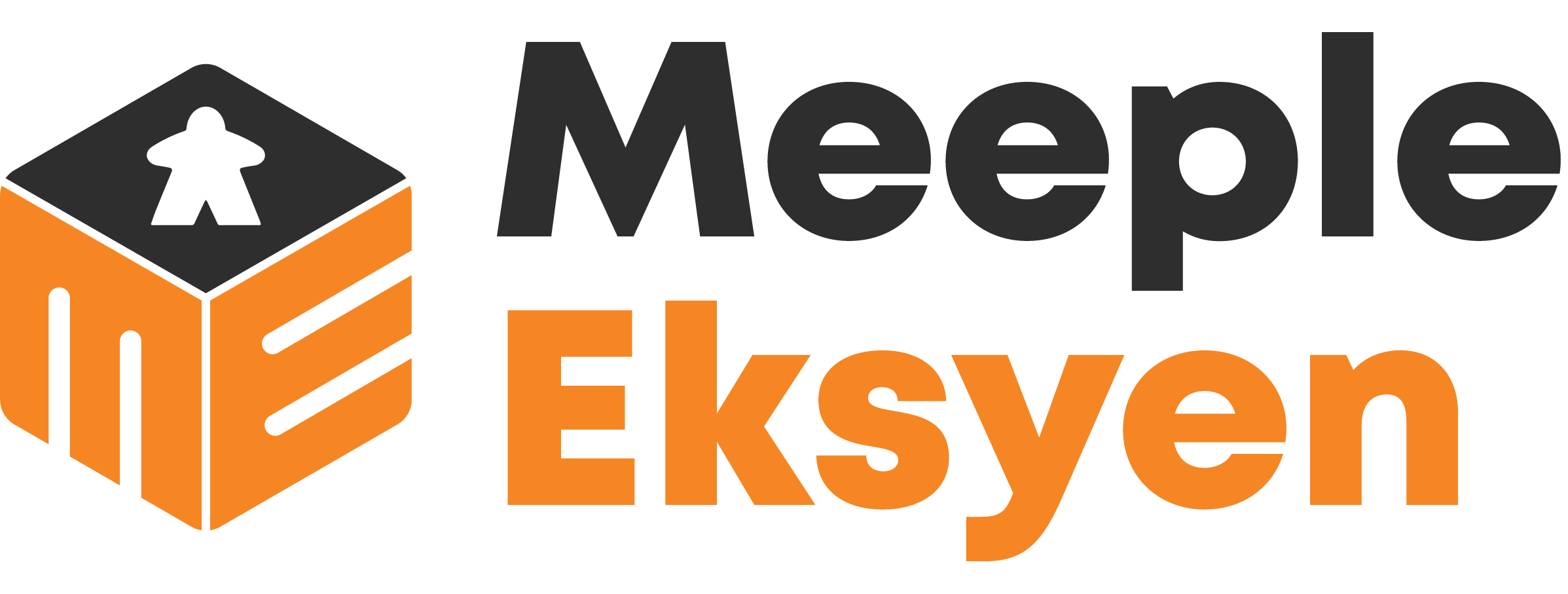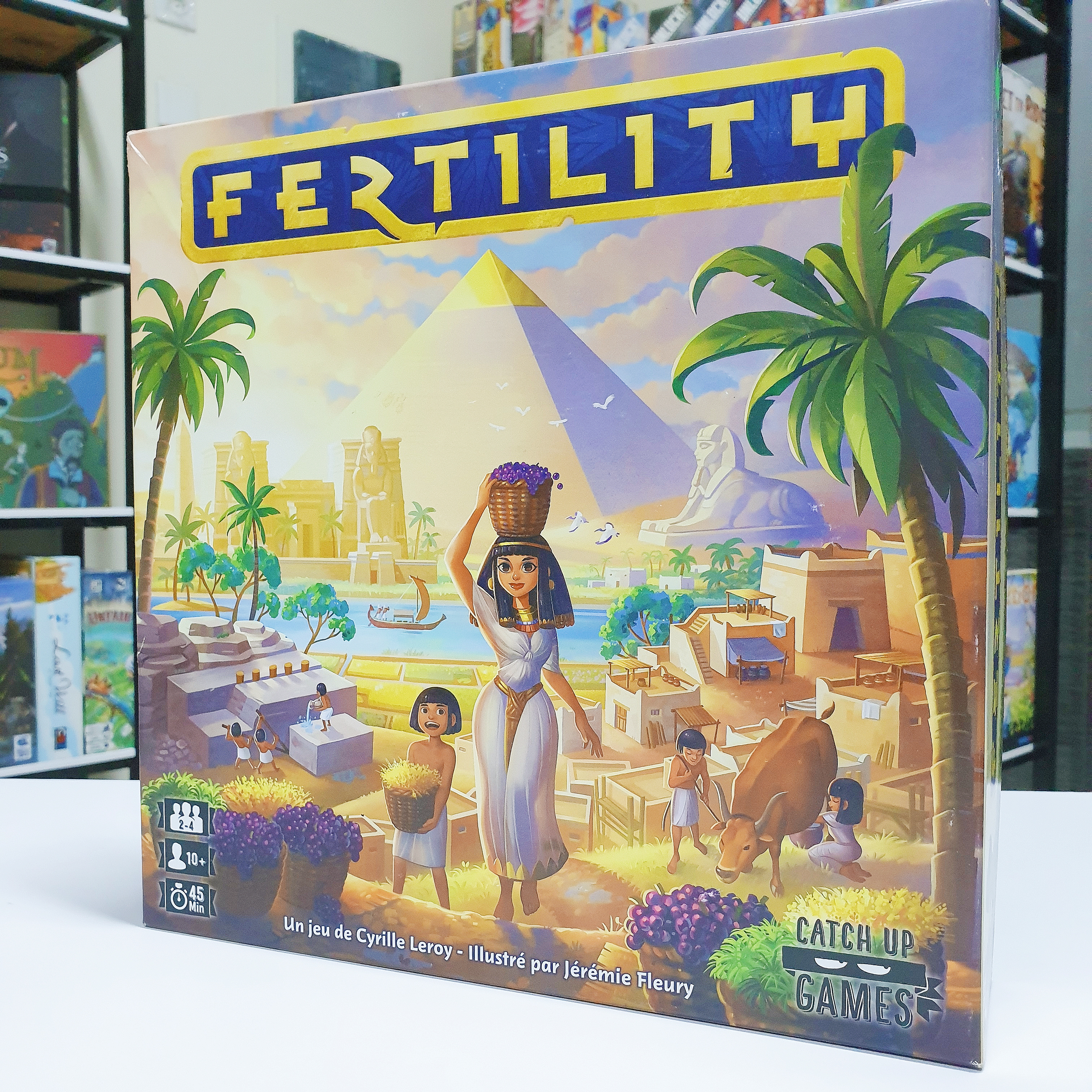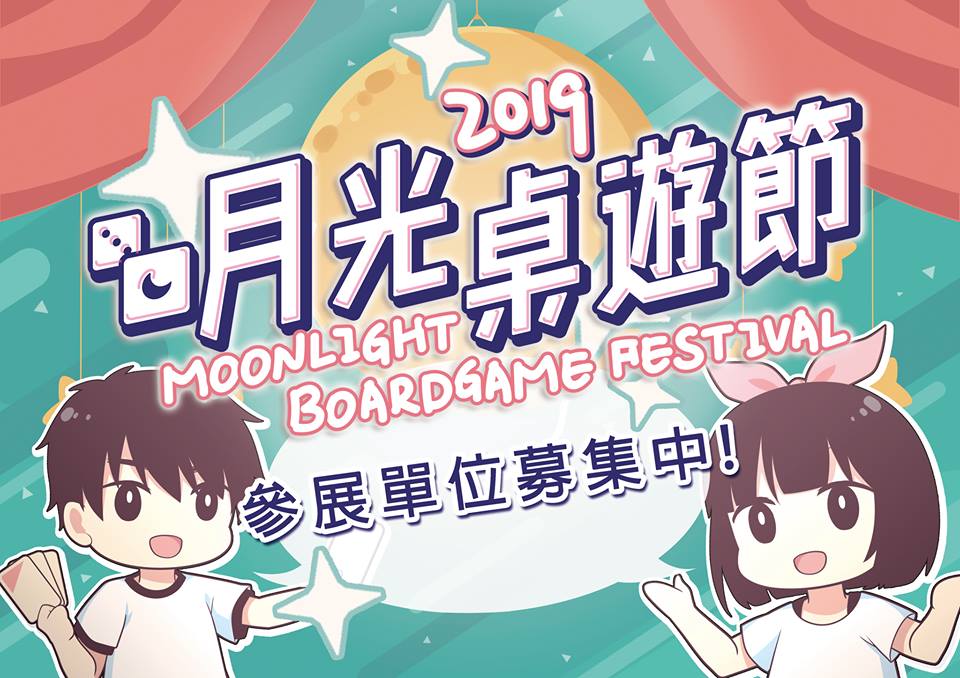Fertility takes you back to Ancient Egypt. The great flood has passed and the sun shines ever so brightly over the Nile River. It is the perfect time of the year. Grab your tools, as the Pharaoh has decreed the start of the farming season. Alabaster, bovines, papyrus flowers, and grapes are in high demand and they provide business opportunities in the Metropolis. It is truly a season of fertility for the entire populace!
About Fertility
Ancient Egypt plus board game? Well, I am sold. The box art is beautiful, depicting the prosperous and thriving region of the Nile Valley. Fertility is a simple tile-placement and resource management game. This game immediately reminds me of playing dominoes, where you place the same-pictured tiles adjacent to each other. You place a tile to gain resources and to set up shop and fill them on your own Metropolis. Filling up shops nets you points at the end of the game and the player with the highest points wins!
A game for two to four players, Fertility is an easy game to learn.
Setting up the game
Setting up a game of Fertility is also quite simple. There are two playing areas in the game. The common area depicts the farming area in the Valley of the Nile. This is where the players put their resource tiles (the domino tiles a.k.a. Valley tiles) to gain the respective resources.
Each valley tile has two sides, similar to an actual domino tile. The common board is a modular board, which consists of four different parts. For the game up to 3 players, use only three board parts. Whereas, in a four-player game, use all of these parts. The number of players also determines the number of Valley tiles. You have to use 24, 35, and 46 tiles in a 2, 3, and 4-player game respectively.
Each District tile contains one or more shops that players can supply during their turn. Reveal three resource tiles and four District tiles to form the common pool. Each board part has a special space that is marked with a special four-coloured square. This marks the space to put the special starting tile. Players choose the special space that is the closest to the centre. Then, place the starting tile on it in any orientation as a starting point for the game.
Next comes the personal area. The personal area depicts a town or metropolis that the Pharaoh has entrusted to you. It is your duty as the proprietors to build shops using shop tiles from the common pool and stock them with resources to generate points (dubbed as Debens). Each player gets their own metropolis board that starts with one free district and an empty wheat storehouse (putting the wheat marker on the 0 space). Additionally, each player gets three resource tiles from the common pile and four monument tokens that can be put on the common board when an opportunity to place it presents itself.
Playing Fertility
A game of Fertility lasts for nine rounds in total, after which the game proceeds to endgame scoring (there is no scoring in the middle of the game). In each round, each player takes turns to place a Valley tile on the common board to gain resources and use said resources to either build a District tile or supply a shop on already built District tiles.
Players have to put a matching Valley tile adjacent to an existing tile on the board, in order to gain the specific resource. For each matching picture, the player gains that number of resources. For instance, if a player puts a tile with alabaster adjacent to each other, that player gains one alabaster. If a player puts a tile with alabaster adjacent to two other alabasters, that player gains, you guessed it, two alabasters. If a player manages to match multiple tile pictures, that player gains all of the resources (i.e. matching a tile of papyrus and bovine to those existing on the board will net the player both of those resources, for instance). The players must place a Valley tile with at least one matching picture.
The common board has four different types of space on it: normal desert space, a desert space with a picture of a certain resource, wheat space, and water space. Players can only place tiles on top of a normal desert space or the space with a resource picture on it. If a player covers the resource picture with a tile, that player gains that resource.
The player cannot put tiles on top of the wheat and water spaces. However, putting a tile adjacent to a wheat space will give player wheat, depending on how many sides touch the wheat space. When a player gains wheat, that player moves his/her wheat marker according to the amount of wheat he or she gets.
If a player puts a Valley tile and forms a single, entirely closed space (surrounded by other tiles and/or wheat space or water space), that player forms a Quarry and gets two options. The first option is taking any of one resource from the stock (either alabaster, bovine, papyrus, or grape). The second option is, by foregoing taking a resource, players can instead place one of their monuments on that empty space. These monuments will be used during the final scoring.
During the turn, players have to use the resources they obtain immediately, except for wheat, which can be stored in the wheat storehouse. At the end of the turn, discard any unused resources (again, except for wheat) back to the common stock. Players use their resources to build a district tile, paying for the cost indicated at the top right corner of the tile and place it on an empty space on their metropolis board. Players can pay for the tile with any mix of resources, as well as using wheat in their storehouse in place of a resource.
After building the district, players need to supply the shops with resources to score points. Each shop has a specific resource requirement and some of them may require two or more resources. In such shops, players may fulfil the requirements partially on their turns, but only completely supplied shops are scored. After a resource is placed in a shop, that resource cannot be removed from the shop and stays there until the end of the game.
Several shops in Fertility
There are several types of shop. The generic shops are the most straightforward type of shop. By supplying the shop with specific resources, it will score points at the end of the game. The second type is known as specialized shops. Specialized shops score points at the end of the game. It depends on the amount of a specific type of resource on that player’s personal board. For example, an alabaster shop will score points depending on the alabasters quantity that player has supplied in all of his/her shops.
The third type of shop is what I like to call as the converter shop. As the name implies, this type of shop converts a resource to another type of resource. By placing the required resource in the shop, that resource is converted immediately. Anyway, the non-removal rule still applies to the shop.
If the shop converts a resource to wheat, move the wheat token up one level. On the other hand, when the shop converts resources, take that resource from the common stock and use it immediately. The fourth type of shop is the statues shop. This type of shop is unique, in which a player supplies the shop with resources to collect the Statue of the Gods depicted in the shop. Each different statue will give players score at the end of the game.
End of the game and scoring
The game lasts for nine rounds or as soon as the common pool cannot be replenished to three tiles, after which the endgame scoring occurs. Players get scores from the points on their generic and specialized shops, their collection of Statues of Gods, number of monuments placed on the common board, and the number of wheat they have in their storehouse. If the number of monuments is tied, then divide the score evenly to the players. The player with the highest total points wins. In case of a tie, the player with the least resources on his/her personal board wins.
Personal opinions
Well, what can I say, except that this game is amazing! I absolutely love the theme and the game is pretty straightforward. Fertility is easy to learn and teach to new players. Combined with its beautiful artwork, it creates a perfect family game. This is a perfect game if you are looking for a short and casual game to play with your friends or family.
I love that the artwork puts so many little details on the tiles. It makes you as a player feel the hustle and bustle of the workers working in the Valley and the busy crowd of an Ancient Egyptian Metropolis. The board parts feature a “locking-pin” mechanism on each of the four edges. I personally find amazing at keeping the board together.
With so many Valley and District tiles, the game will surely feel different every time we play Fertility, making the replayability quite high. However, it can certainly be an improvement by adding more variations of the common board parts. The game comes with only four board parts and although, rearrangements of the parts will give slightly different layouts, having more variations will not hurt. The only downside to the game is the monument tiles, which has a very loose base connection. This is, however, purely cosmetic.
One of my favourite aspects is the mechanism where we have to discard unused resource at the end of a player’s turn. This restricts a player’s movement in a good way and makes you think efficiently. It is almost always a better idea to just grab resources you need rather than thinking about blocking your opponents. The utilization of a “dead” single space on the board to gain an advantage is also an amazing aspect of Fertility. This aspect adds more depth to the game.
Conclusion
If you are looking for an easy-to-learn, colourful, tile placement and resource management game, then look no further! Fertility is here to satisfy you in all of those aspects. A perfect game to show the beauty of board games to your young kids or significant other.













